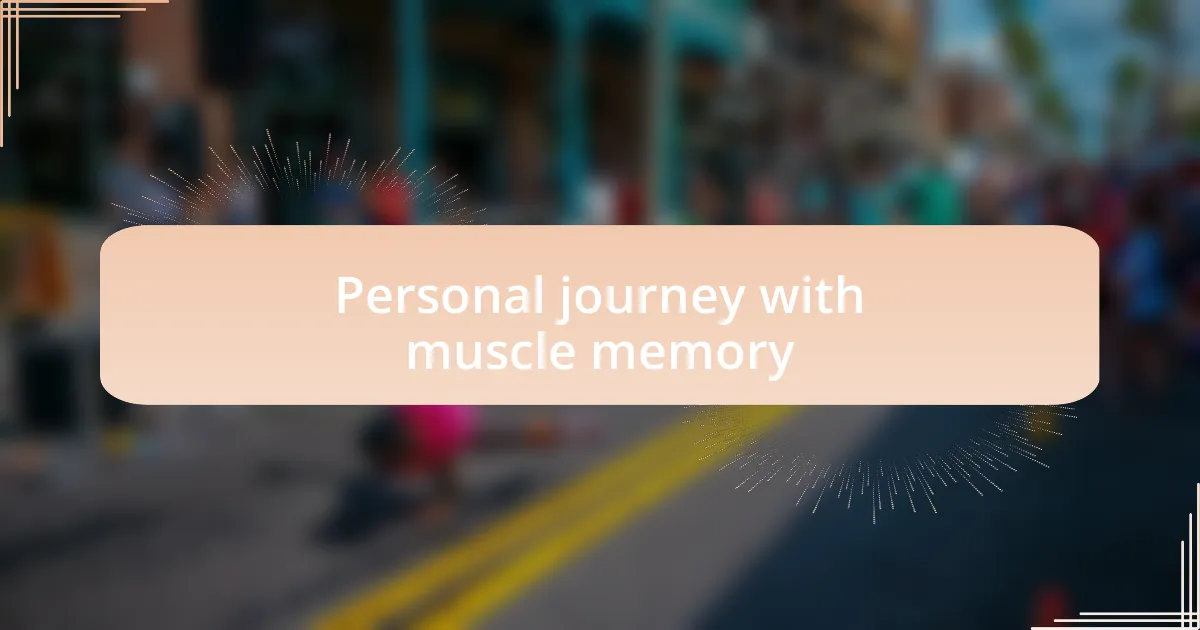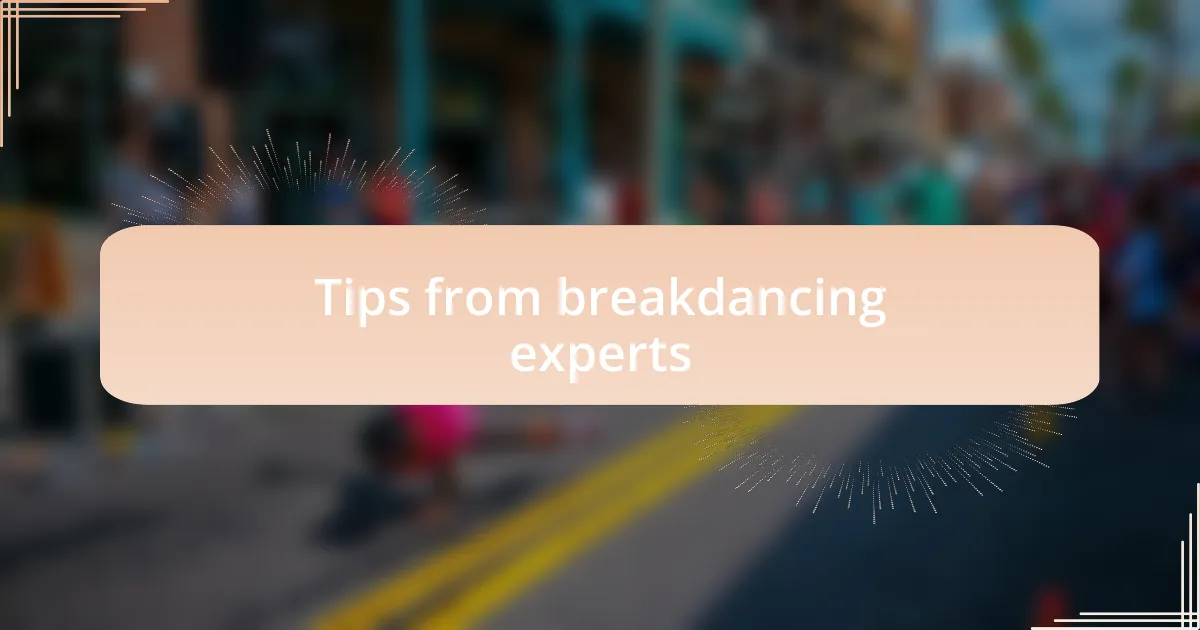Key takeaways:
- Muscle memory enables complex movements to be performed with ease through repeated practice, engaging both brain and body.
- Consistency, breaking down moves into smaller parts, and visualization techniques are essential for developing muscle memory effectively.
- Muscle memory is a continuous journey, requiring mental engagement and revisiting fundamentals to maintain skills over time.
- Expert tips emphasize the significance of detail-oriented practice, mental rehearsal, and cross-training to enhance performance and memory retention.

Understanding muscle memory
Muscle memory is fascinating because it allows our bodies to perform complex movements with ease after they’ve been repeated enough times. I remember the first time I learned a windmill—my body felt clumsy and awkward. But after countless attempts, I could execute it flawlessly without even thinking. Have you ever experienced that feeling of flow where your body just knows what to do?
When we train our muscles, we’re essentially teaching them to remember specific movements. This process happens in our brain, too, which retains information about these actions. I often think about how the rhythm and coordination of breakdancing steps become second nature. It’s almost like I can call on my body to perform a move just by visualizing it. Isn’t it incredible how our brains and muscles work together?
The beauty of muscle memory lies in its transformative power; it doesn’t just apply to breakdancing but to many physical activities. There were times when I returned to practice after a long break, and despite feeling rusty at first, those hard-earned skills resurfaced quickly. Have you noticed how that familiar motion comes back, almost as if the body stores a sense of history with each move? That’s the magic of muscle memory in action.

How muscle memory enhances performance
Muscle memory significantly enhances performance in breakdancing by allowing dancers to perform intricate moves more fluidly and confidently. I’ve found that when I practice the same routine repeatedly, my body transitions between moves with an ease that makes it feel almost effortless. It’s as if my muscles start to communicate, anticipating the next movement, which allows me to focus more on creativity and expression rather than mechanics. Have you ever felt that thrill when you nail a move that once felt impossible?
I remember working on my flare for weeks, feeling frustrated at times. But once it clicked, the sensation of floating through the air became second nature. It’s remarkable how, with enough repetition, the brain recalls not just the physical actions but also the emotion tied to each move. The exhilarating rush of hitting a perfect sequence isn’t just about the body; it’s a full-body experience—one that muscle memory cultivates over time.
As we harness muscle memory, our overall performance improves right before our eyes. The confidence that comes from knowing you can execute a challenging move opens up new avenues for creativity in dance. When I step onto the floor, I feel a sense of freedom; my body knows its capabilities, allowing me to explore and innovate. Do you remember the last time you felt that exhilarating confidence during a session? It’s muscle memory that gets us there.

Techniques to develop muscle memory
When developing muscle memory, consistency is key. I’ve found that dedicating specific times to practice certain moves helps lock them into my memory. For instance, I set aside a half-hour daily to hone my top rock, and soon enough, my feet seemed to know exactly where to go without me thinking about it. Have you ever noticed how repetition can turn a confusing sequence into a fluid routine?
Another technique that works wonders for me is breaking a move down into smaller parts. I remember when I was trying to perfect my windmill. It was only after I isolated each component—starting from the kick to the final freeze—that I could string it all together smoothly. This approach not only makes learning feel less overwhelming but also allows me to celebrate each milestone along the way. Have you ever experienced that satisfying feeling of mastering just one small section of a complicated move?
Lastly, incorporating visualization techniques can significantly enhance how quickly you develop muscle memory. I often find myself imagining the motions and transitions even when I’m away from the dance floor. It’s fascinating how visualizing my movements, like executing a clean airflare, primes my body for the real thing next time I practice. Have you tried visualizing your sequences? It’s a game-changer that bridges the gap between mind and muscle.

Personal journey with muscle memory
There was a time when I struggled to link my mind and body during my sessions. I remember feeling frustrated as the moves I practiced in my head didn’t translate to the floor. It was during one particularly grueling practice that I finally realized muscle memory develops more than just through physical repetition; it also requires mental engagement. Have you ever felt like the moves just weren’t clicking, no matter how much you practiced?
As I progressed, I found joy in those moments when muscle memory kicked in unexpectedly. The first time I successfully executed a flaring combo without overthinking it felt surreal. It was as if my body had taken over, seamlessly flowing from one move to the next. Can you recall that exhilarating moment when everything just clicks, and you dance with a confidence you never thought you had?
Still, I learned that muscle memory isn’t a one-and-done achievement; it’s a continuous journey. I often revisit the basics and reinforce my foundation since I’ve noticed how easily muscle memory can fade. How often do you check back on the fundamentals? Those little reminders ensure that the skills I’ve honed remain sharp and ready for when I need them most.

Tips from breakdancing experts
When I spoke with seasoned breakdancers, they all emphasized the importance of consistency. One expert shared a memorable session where he practiced the same move for hours without success. It wasn’t until he focused on small details, like foot placement and body alignment, that everything fell into place. Have you ever noticed how minor adjustments can unlock a move?
Another tip from a veteran dancer revolved around visualization. He insists that mental rehearsals are just as crucial as physical practice. I remember trying this technique before a competition; picturing myself executing every step with precision. When I finally hit the stage, it felt like I had already danced that routine a hundred times in my mind. Isn’t it fascinating how our brains can prepare our bodies for what’s to come?
Lastly, never underestimate the power of cross-training. One expert highlighted how incorporating strength training and flexibility into your routine can enhance muscle memory. I took his advice to heart and noticed significant improvements in my balance and control during routines. Have you considered mixing up your training to elevate your breakdancing skills? It can truly make a difference in how your body remembers the moves.